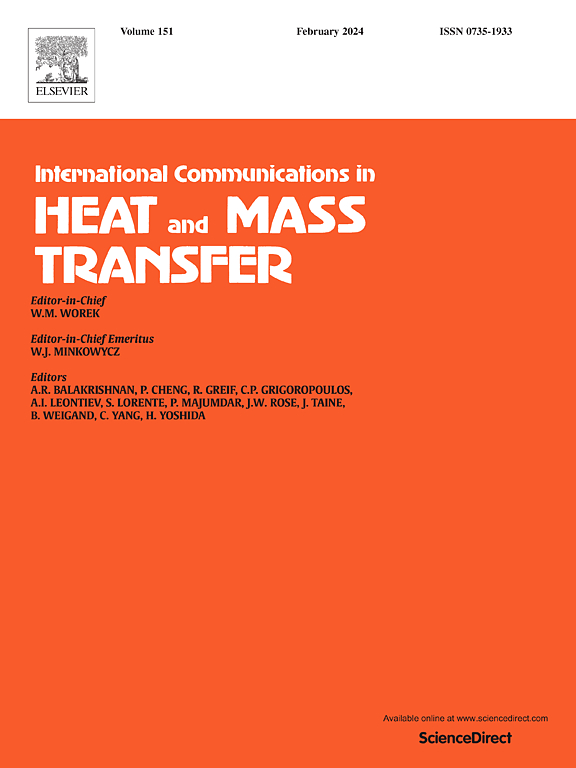热管辅助的蜂窝状壳盘管潜热蓄热装置的研制与实验研究。基于面向对象建模的熔融过程动态仿真
IF 6.4
2区 工程技术
Q1 MECHANICS
International Communications in Heat and Mass Transfer
Pub Date : 2025-07-18
DOI:10.1016/j.icheatmasstransfer.2025.109379
引用次数: 0
摘要
本研究采用椰子油作为相变材料(PCM),设计了一种模块化潜热储能(TES)装置,以提高储能效率。该研究旨在解决小型TES系统在太阳能和废热回收等应用中的高效传热挑战。该装置采用新颖的蜂窝壳盘管结构,采用铝螺旋盘管和铜热管,通过循环传热流体将热量传递到PCM。实验在两种工况下进行:进口温度为34.5℃,流速为1.2 L/min;进口温度为33℃,流速为1.7 L/min。结果表明,体积能量密度为38 kWh/m3,最大充电速率为0.5 kW。使用归一化传热性能系数(NHTPC)和体积能量密度(VED)来评估性能,与其他TES设计相比,显示出具有竞争力的效率。在Modelica中使用面向对象建模开发了一个动态模型,准确地预测了温度和热流密度,并与实验数据进行了验证,最大误差为6%。这项工作介绍了一种可扩展的模块化TES设计和一种新颖的NHTPC与VED比较方法,为未来优化热能储存系统提供了巨大的潜力。本文章由计算机程序翻译,如有差异,请以英文原文为准。
Development and experimental investigation of a modular, honeycomb shell-and-coil PCM-based latent heat thermal energy storage unit assisted with heat pipes. Dynamic simulation of melting process by using object-oriented modeling
This study investigates a modular latent heat thermal energy storage (TES) unit designed to enhance energy storage efficiency using coconut oil as the phase-change material (PCM). The research aims to address the challenge of efficient heat transfer in compact TES systems for applications like solar energy and waste heat recovery. The unit features a novel honeycomb shell-and-coil structure with aluminum helical coils and copper heat pipes, facilitating heat transfer to the PCM via circulated heat transfer fluid. Experiments were conducted under two regimes: 34.5 °C inlet temperature with 1.2 L/min flow rate and 33 °C with 1.7 L/min. Results demonstrate a volumetric energy density of 38 kWh/m3 and a maximum charging rate of 0.5 kW. Performance was evaluated using the normalized heat transfer performance coefficient (NHTPC) and volumetric energy density (VED), showing competitive efficiency compared to other TES designs. A dynamic model, developed using object-oriented modeling in Modelica, accurately predicts temperature and heat flux, validated against experimental data with a maximum discrepancy of 6 %. This work introduces a scalable, modular TES design and a novel NHTPC vs. VED comparison methodology, offering significant potential for optimizing thermal energy storage systems in the future.
求助全文
通过发布文献求助,成功后即可免费获取论文全文。
去求助
来源期刊
CiteScore
11.00
自引率
10.00%
发文量
648
审稿时长
32 days
期刊介绍:
International Communications in Heat and Mass Transfer serves as a world forum for the rapid dissemination of new ideas, new measurement techniques, preliminary findings of ongoing investigations, discussions, and criticisms in the field of heat and mass transfer. Two types of manuscript will be considered for publication: communications (short reports of new work or discussions of work which has already been published) and summaries (abstracts of reports, theses or manuscripts which are too long for publication in full). Together with its companion publication, International Journal of Heat and Mass Transfer, with which it shares the same Board of Editors, this journal is read by research workers and engineers throughout the world.

 求助内容:
求助内容: 应助结果提醒方式:
应助结果提醒方式:


